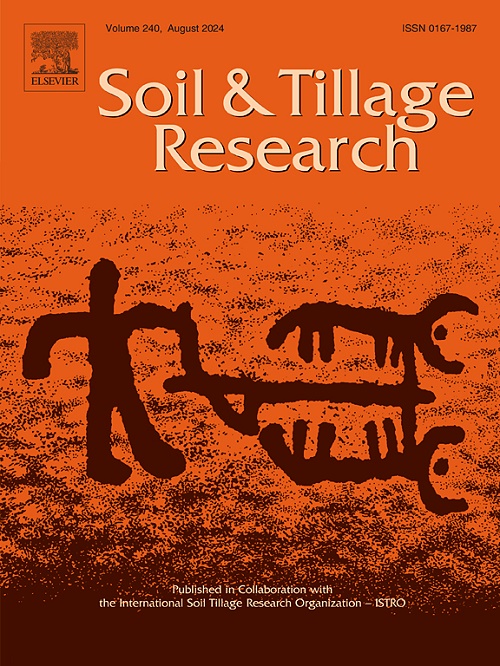施用单一酸化生物炭对盐碱地的双重影响:短期盐渍化风险和持久的营养效益
IF 6.1
1区 农林科学
Q1 SOIL SCIENCE
引用次数: 0
摘要
土壤盐碱化是农业可持续性的主要制约因素。虽然酸化生物炭有望改善盐碱地,但其在不同水管理制度下的长期有效性尚不清楚。本研究通过为期3年(2021-2023)的田间试验,评估了酸化生物炭在新疆盐碱地单次施用的可行性。我们评估了四种灌溉定额(60 %、80 %、100 %和120 %等)下四种生物炭含量(0、10、20和30 t hm - 1)对土壤盐分、碱度和养分的短期和持续影响。采用熵权- topsis模型确定最优管理策略。结果表明,酸化生物炭在持续提高土壤养分有效性的同时,使表层土壤(0 ~ 40 cm)总含盐量(18.3 % ~ 34.0 %)和pH值(0.6 % ~ 2.1 %)在第一年短暂增加。这种最初的影响是暂时的,并随着时间的推移而逆转;到2023年,与对照相比,土壤盐度(15.7% % -60.1 %)和碱度(18.5% % -28.5 %)显著降低。较高的灌溉定额通过稀释和淋滤有效地减轻了初始盐渍化风险,但也可能增加养分损失。通过多目标决策分析,确定了一个动态优化策略:第一年采用20 t ha-1生物炭和120 % ETc灌溉的最佳组合,随后几年将ETc减少到100 %,以尽量减少养分损失。我们的研究结果表明,单一施用酸化生物炭,加上动态调节灌溉,是盐碱地长期改良的可持续有效策略。本文章由计算机程序翻译,如有差异,请以英文原文为准。
Dual impact of single acidified biochar application on saline-alkaline soil: short-term salinization risks and persistent nutrient benefits
Soil salinization is a major constraint on agricultural sustainability. While acidified biochar shows promise for ameliorating saline-alkali soils, its long-term efficacy under different water management regimes is not well understood. This study assessed the feasibility of a single application of acidified biochar in a saline-alkali soil in Xinjiang through a three-year field experiment (2021–2023). We assessed the short-term and persistent effects of four biochar rates (0, 10, 20, and 30 t ha–1) under four irrigation quotas (60 %, 80 %, 100 %, and 120 % ETc) on soil salinity, alkalinity, and nutrients. An entropy weight-TOPSIS model was employed to identify optimal management strategies. Results showed that while acidified biochar consistently enhanced soil nutrient availability, it caused a transient increase in surface soil (0–40 cm) total salt content (18.3 %–34.0 %) and pH (0.6 %–2.1 %) in the first year. This initial effect was temporary and reversed over time; by 2023, significant reductions in soil salinity (15.7 %–60.1 %) and alkalinity (18.5 %–28.5 %) were observed relative to the control. Higher irrigation quotas effectively mitigated the initial salinization risk through dilution and leaching but could also increase nutrient loss. The multi-objective decision-making analysis identified a dynamic optimal strategy: an optimal combination of 20 t ha–1 biochar and 120 % ETc irrigation in the first year, followed by a reduction to 100 % ETc in subsequent years to minimize nutrient loss. Our findings demonstrate that a single application of acidified biochar, coupled with dynamically adjusted irrigation, is a sustainable and effective strategy for the long-term amelioration of saline-alkali soils.
求助全文
通过发布文献求助,成功后即可免费获取论文全文。
去求助
来源期刊

Soil & Tillage Research
农林科学-土壤科学
CiteScore
13.00
自引率
6.20%
发文量
266
审稿时长
5 months
期刊介绍:
Soil & Tillage Research examines the physical, chemical and biological changes in the soil caused by tillage and field traffic. Manuscripts will be considered on aspects of soil science, physics, technology, mechanization and applied engineering for a sustainable balance among productivity, environmental quality and profitability. The following are examples of suitable topics within the scope of the journal of Soil and Tillage Research:
The agricultural and biosystems engineering associated with tillage (including no-tillage, reduced-tillage and direct drilling), irrigation and drainage, crops and crop rotations, fertilization, rehabilitation of mine spoils and processes used to modify soils. Soil change effects on establishment and yield of crops, growth of plants and roots, structure and erosion of soil, cycling of carbon and nutrients, greenhouse gas emissions, leaching, runoff and other processes that affect environmental quality. Characterization or modeling of tillage and field traffic responses, soil, climate, or topographic effects, soil deformation processes, tillage tools, traction devices, energy requirements, economics, surface and subsurface water quality effects, tillage effects on weed, pest and disease control, and their interactions.
 求助内容:
求助内容: 应助结果提醒方式:
应助结果提醒方式:


